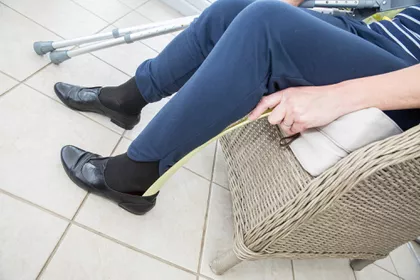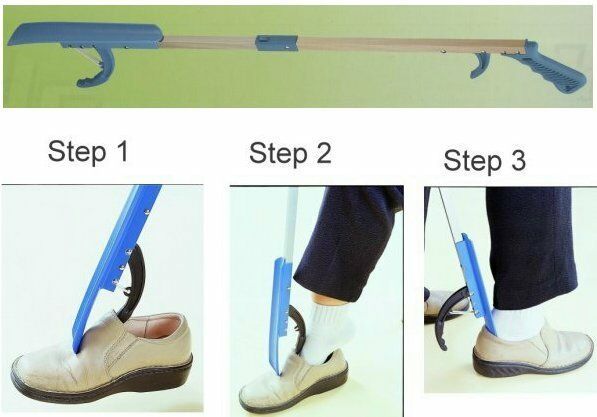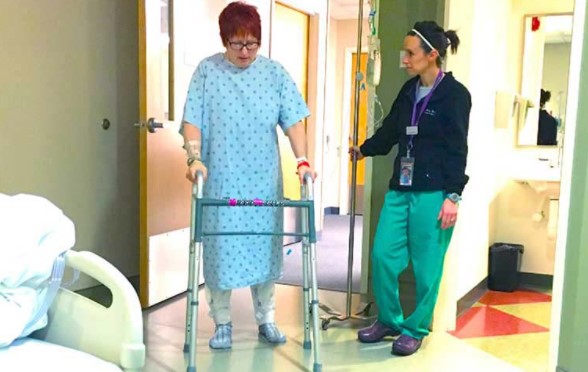Post-operative precautions for hip replacement can be really infuriating, especially movement restrictions. For instance, you can not bend your hips or knees more than 90 degrees. So, how are you supposed to pick something up, or wear shoes? As a result, many patients are left wondering, “How long after hip replacement can I tie my shoes?”
Gradually coping up with the newly replaced hip is a must, but you should never rush the rehabilitation process. Therefore, it is advisable only to tie your shoelaces when the healing process is over in about 6 to 8 weeks.
But what type of shoes should you put on? In this article, discover the ways you can tie up shoelaces after hip replacement, along with how far you can walk after hip replacement, and more. Let’s get to it.
How Long After Hip Replacement Can I Tie My Shoes?
After a hip replacement surgery, it can take up to 6 to 8 weeks before you can perform certain body actions like tying your shoelaces, picking up things, bending down, and more. Also, within this period, you should be able to cross your legs and sit comfortably, sleep on one side, and even drive.
Basically, there are two forms of hip replacement surgery: the Anterior and the traditional Posterior (Hardinge / Antero-lateral) approach. These two different approaches can affect the time it takes before performing certain actions after the replacement is done.
Let us discuss these approaches for better comprehension.
The Anterior Approach
The Anterior hip replacement technique requires minimal hip surgery. This method does not involve cutting tendons or muscles, just as it is with traditional hip replacement. So, patients who undergo anterior hip replacement procedure will likely recover faster, within 2-3 weeks.
Unlike the traditional Posterior where muscles need to heal before a patient can bend over, the Anterior method does not need the tendon or muscles to heal. This means that after an Anterior approach is done, you can engage in mild chores such as tying shoelaces only after a couple of weeks.
However, if in case you can’t perform such a simple task, your hip muscles may have not stretched out enough and you’ll have to wait a few more weeks for full recovery.
Traditional Posterior
On the other hand, the traditional Posterior is a more intense procedure that takes quite a long rehabilitation process. Here, the surgeon cuts across the surrounding muscles and tendons and reattach them at the end of the process.
This procedure requires a healing process of 6 to 8 weeks. During this healing period, the surgeon will advise the patient to avoid bending. So, unfortunately, this means it can take up to eight weeks before patients will be allowed to tie their shoelaces.
If this is the situation, you may want to wait up to eight weeks before attempting any chores, as you do not want to cause any further damage. You can always seek some medical advice from your doctor as to when you are allowed to perform certain actions and do simple chores.
Other factors that can affect the time it takes a patient to recover may include-
- Age
- Nutrition
- Physical activity before the surgery
- Pre-existing health conditions
- Lifestyles, and others.
How Do I Tie My Shoes After Hip Replacement?
The first thing to keep in mind is, you should not try to tie your shoes after hip replacement as this can be detrimental to your health. You can only tie your shoelaces when the healing process is already complete, which takes about 6 to 8 weeks. An alternative to this is tying the shoelaces before wearing them. But ensure the laces are loosely tied for easy wearing.
To this effect, there is a process you can employ to wear your shoes while keeping yourself safe. The following aspect will uncover this process in detail.
Steps to Wearing Your Shoes after Hip Replacement
Step-1: Tie the shoelaces loosely before wearing them.
You can also try out a slip-on. But the shoe must not be so tight so that it causes any difficulties while wearing.
Step-2: Use a reacher, and a lengthy handled shoehorn.
These tools are necessary for wearing your shoes after a hip replacement surgery.
Step-3: With a reacher, hold the tongue of the shoes.
Step-4: Using the long handheld shoehorn, grab the heel.
Step-5: Slip your foot into the shoe while holding on to the reacher and the shoehorn simultaneously.
Remember, making unnatural body positions after a hip replacement can lead to further damage. So, when you’re wearing or taking off your shoes, try not to take a look at the outside of your ankle.
What Type Of Shoes Should I Wear After Hip Surgery?
The most preferred type of shoes you should wear after hip surgery is one that has a low/flat but wide heel. An example is a tennis shoe, which possesses good shock absorption or running shoes for sprinting on grass. And if you’re wearing dress shoes, make sure the heels do not go beyond 2 inches and must have a wide heel without spikes.
Before deciding on a particular shoe to get, you must consider features and build that provides enough comfort and support. Just like I mentioned above, some of these features include a low and a wide heel, in addition to shock absorption properties, lightweight build, and more.
Here’s a more detailed overview.
Construction
The overall construction of the shoes plays a great deal while choosing shoes after hip replacement. The right shoes must be constructed in such a way that they offer the maximum amount of comfort. You should avoid getting something that obstructs your natural movements or makes you feel uncomfortable while walking.
Lightweight and Flexibility
Lightweight shoes are a must if you want to keep your natural walking pattern. Also, the shoes’ flexibility is an added advantage, as it allows the free movement of your feet while you walk.
Insole
The best shoes should offer a high level of rebound capability, and that can only come from a cushioning insole. Look out for shoes with PU insoles that offers excellent comfort, or orthotic insoles for better medical beenfits.
Shock Absorption / Resistance
This feature is not negotiable for a patient, as it helps you overcome sudden trips and falls. The outer layer of the sole should be rigid enough to endure scratches while it provides added arch support to your feet. Also, you’ll need decent shock absorption from the heel construction. Putting these features and designs together makes this type of shoe suitable to wear after hip surgery.
How Far Should I Be Walking After Hip Replacement?
After a hip replacement surgery, you are advised to walk just a few hundred yards a time. This is how far you can go a day for first few weeks, depending on what type of hip surgery you had, until the healing process is over. During this time, the implants are properly fused with the bone.
In addition, you can decide to take a walk up to 2 or 3 times a day, and each of these walks can last for about 20 to 30 minutes. Finally, you can attempt to practice your walking around the house every one to two hours with decent intervals. At the same time, walking and standing for over ten minutes with little weight on your crutches or walker is advisable.
For some patients, hip replacement recovery could last for up to 2 to 4 weeks. This may be different for others as sometimes, and usually, it takes up to 8 weeks for a notable recovery. You should monitor your recovery process with the help of your doctor, as this will help you understand the possible changes that occur and what precautions you need to take after hip surgery.
How Long Does It Take To Walk Normally After Hip Replacement?
After a hip replacement surgery, most patients can walk normally after the initial 3 to 6 weeks of recovery. However, some can perform partial movements within the same day or the following day of the surgery.
Once you can carry out some light activities, it is quite essential to include some healthy body exercises into their daily recovery program. Some additional things you can consider to improve their recovery include:
- Pay attention to weight and diet
- Exercise hip and leg muscles to promote better blood flow
- Decorate your house in such a way that it’ll require minimum movements to reach frequently used equipment.
- Maintain good body hygiene.
Is It Possible To Run After Hip Replacement Surgery?
It is not advisable to run after hip replacement surgery. Some surgeons even discourage the idea of going back to running after a hip surgery. Though in most cases, it is possible to get back to running. But this depends on the prosthetic materials employed to fix the affected hip joint and the quality of the bone.
But why shouldn’t you run after hip replacement surgery?
During the surgery, damaged bone and cartilage are taken out and substituted with metal, ceramic, or plastic surfaces. In some cases, surgeons may apply cement to bond the bone with the artificial joint. Physical activities like running can result in sudden impact, putting a lot of risk to the prosthesis and stem fracture. This can enhance damage to the surface of the prosthetic components.
As such, since running is a jarring activity to engage in after hip surgery, there is a need for extra caution.
Bottom Line
Hip replacement surgery could be risky; you need to know the right time you are allowed to perform certain actions and body movements. This even includes pesky chores like tying shoelaces. And that’s why many patients wonder, how long after hip replacement can I tie my shoes?
The safest time for a patient to perform slight chores and body movements after hip surgery is within the sixth to eighth week of recovery. But this timeframe is variable. However, no matter how long your recovery take, you should avoid rush the process and maintain a balance routine at any cost.






